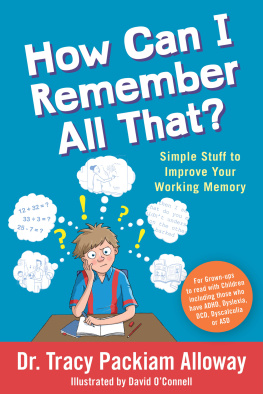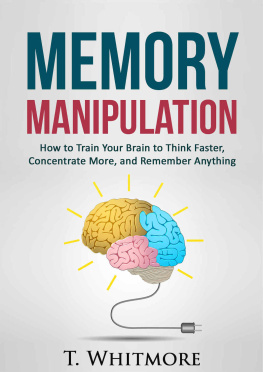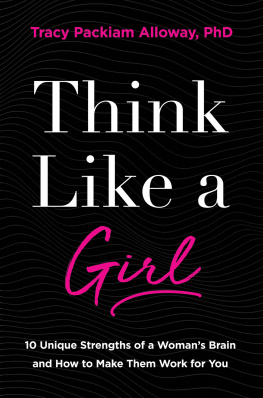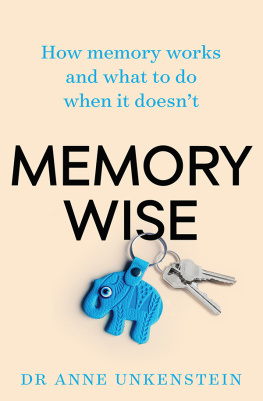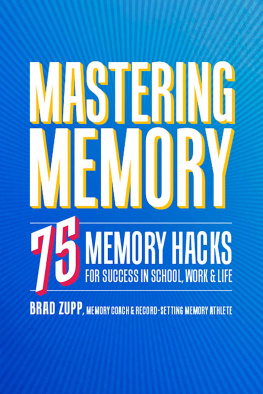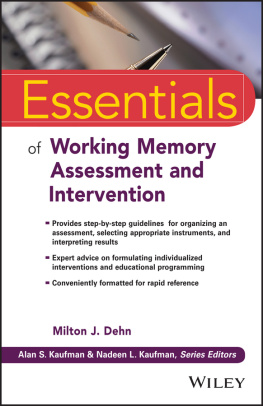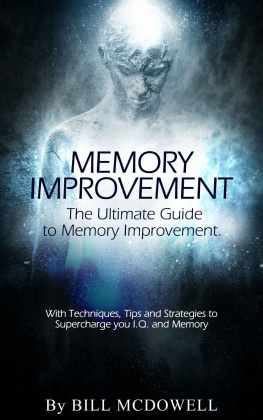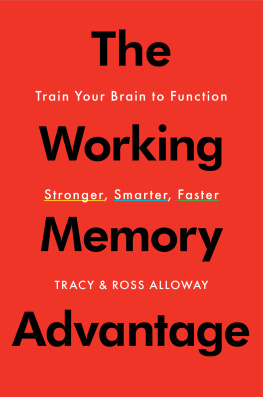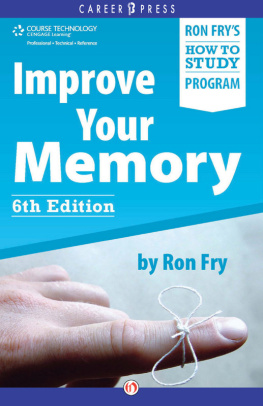
How Can I
Remember
All That?

Simple Stuff to Improve Your Working Memory
Dr. Tracy Packiam Alloway
Illustrated by David OConnell

Jessica Kingsley Publishers
London and Philadelphia
Contents

Preface
My name is Dr. Tracy Alloway. I am a psychologist and have spent over a decade researching working memory, our ability to remember and process information. I have shared my research all over the world from Japan to Germany, to Norway, to the USA. Ive worked with children with attention deficit hyperactivity disorder (ADHD), dyslexia, autism, anxiety, and other difficulties that affect their learning, all of whom may struggle with their working memory. Although I and other psychologists talk about what working memory is and how it works to adults, very few people have spent time explaining working memory from the childs perspective.

So when I was approached to write this book, I was so excited because I could share working memory from a childs viewpoint and in a way kids could understand.
My son Marcus drew this picture, which inspired David the illustrators drawings of Tommy, the boy in this book who has working memory issues.
How to use this bookfor grown-ups
How Can I Remember All That? is for children and grown-ups to read together. I have written it in two voices: Tommys and mine.
Tommy is a boy with working memory problems, and he shares what it is like for him in the classroom and on the playground. If a child you care for or work with has similar struggles, you can take frequent pauses as you read this book together, to discuss with them if theyve ever felt or experienced similar things.
What is working memory? Its not the same as IQ! IQ tests are a way to measure how smart we are. Both IQ and working memory are important for learning. A child can have working memory issues and a very high IQ. Or the other way round.
I tested a few hundred children in kindergarten and tracked their school work over six years. I found that your working memory is really important from kindergarten onwardsif you have a strong working memory at kindergarten it can help you do well in school, even six years later! Supporting a child who has working memory issues, who may do less well in things like reading, writing, and math, is very important.
And the good news is that there is a lot that we can doonce we know what signs to look foras youll find out in this book.
As we began to understand more about how working memory affects learning, we have also discovered ways to support working memory. Brain training is a growing and exciting new areathere is a lot of evidence of the brains plasticity: that it can actually change depending on what we do.
As you read this book, you will discover that little tweaks and changes to daily life can make a big difference in supporting working memory.
At the end of the book there is a short section for adults. Here you will find out more about signs and behaviors to look out for in a child that reflect that they struggle with working memory.
There is also information about how you can test for working memory issues and further reading.
Introduction
Introducing working memory
You may be wondering what working memory is.
Some people call working memory our active memory , because we use it to remember new facts, like the name of a new friend, but also to work with things we already know.
Working memory is also the memory that helps us multitask. We use it to do more than one thing at a timelike listen to our parents and do what they tell us.
Working memorythe brains Post-it Note
Working memory is like a Post-it Note. We use it to store information that we need to remember.
TOMMY
My name is Tommy and I know that my Post-it Note isnt as big as some of my friends, because I dont always remember things. Like yesterday, the teacher told us what chapters to study for the test, but when I got home, I had already forgotten.
Sometimes when I concentrate really hard, it feels like my Post-it Note gets larger and I can remember so many things. I still remember the time my best friend Sam told me the name of his favorite movie. And that was last month!

Working memory versus long-term memory
You may think that working memory is the same thing as long-term memory. But long-term memory is different. Its like a library where we keep all the things that we have learned, such as memories from our childhood. It also refers to the knowledge that we have gathered over the years, like facts about a country ( the Taj Mahal is in India ), mathematical knowledge ( 8 + 2 = 10 ), and grammar rules.

We can think of working memory like a librarian who pulls out the facts when we need them. For example, if we are planning a trip to a country that we havent visited before, working memory learns new facts and then draws on long-term memory to make connections between the new country and a familiar place.
Working memory versus short-term memory
Working memory is also different from short-term memory, which is our memory that only lasts for a brief period, usually a few seconds. We use short-term memory to remember someones name, a phone number, or a title of a book. We usually forget this information if we dont make an effort to store it in our long-term memory.
Imagine that you are walking to a new school. You lose your way and stop to ask for directions. You repeat the information to yourself so you dont forget. You are using your short-term memory to remember these directions.
As you recite the directions to yourself, you look around and match them to the road names. Is this where you make that right turn? Where do you make that second left? Now you are using your working memory because you are working with information that you were given.
Working memory in my brain

Each part of the brain has a special job. There is a part of our brain that specializes in working memory. Its in the front and it is called the prefrontal cortex . If you touch your hand to your forehead its almost like you are touching your working memory.
Working memory is a team player. When we use our working memory, it doesnt work aloneit works works with different parts of the brain.
Imagine working memory in the brain as being more like basketball than tennis. Here is what happens when you are having a conversation with your friend Sam.
Sam is talking. Your prefrontal cortex is activatedit has control of the ball! Then it gets information and passes the ball to the brain area that deals with language, which is called Brocas area . This part of the brain then passes the ball back to the prefrontal cortex so you can answer Sams question.
Next page
